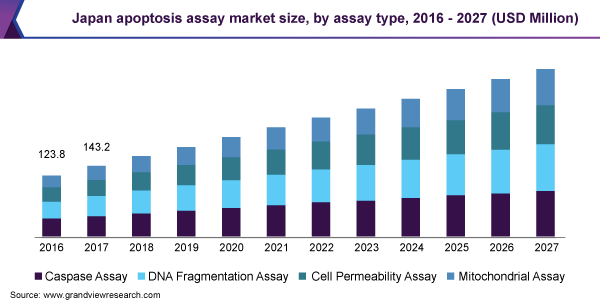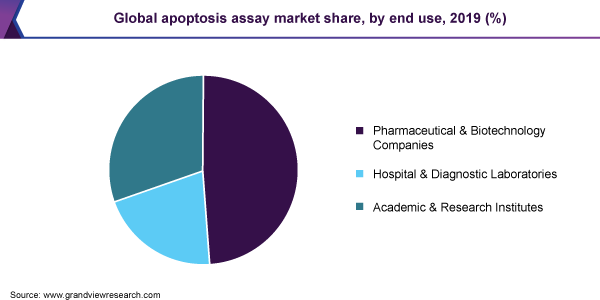- Home
- »
- Biotechnology
- »
-
Apoptosis Assay Market Size, Industry Report, 2020-2027GVR Report cover
![Apoptosis Assay Market Size, Share & Trends Report]()
Apoptosis Assay Market Size, Share & Trends Analysis Report By Product (Kits, Reagents), By Assay Type (Caspase, DNA Fragmentation), By Technique, By End Use, By Region, And Segment Forecasts, 2020 - 2027
- Report ID: GVR-4-68039-134-2
- Number of Report Pages: 140
- Format: PDF, Horizon Databook
- Historical Range: 2016 - 2018
- Forecast Period: 2020 - 2027
- Industry: Healthcare
Report Overview
The global apoptosis assay market size was valued at USD 4.2 billion in 2019 and is expected to grow at a compound annual growth rate (CAGR) of 7.6% from 2020 to 2027. The cell death mechanism plays a key role in the onset and progression of several human chronic conditions, wherein cell-death assays have potential in designing strategies. These strategies are chiefly targeted toward modulating the apoptosis pathway for therapy development. In addition, wide acceptance of clinically useful cytoprotective and cytotoxic agents that can be used in the treatment of ischemic diseases, cancer, and neurodegenerative diseases has led to an increase in the adoption of High-Throughput Screening (HTS) assays; thereby driving the demand for cell-death assays over the years.

Moreover, the advent of novel radionuclide tracers, such as caspase inhibitors and radiolabeled annexin V, has enhanced the efficiency of real-time monitoring of cellular death. For example, ANNEXIN V kits have undergone various modifications, with a growing preference toward radiolabeled ANNEXIN V kits. Controlling and understanding the mechanisms involved in different steps of apoptosis aid in novel drug discoveries. Also, high demand for caspase activity assays along with Bcl-2 protein family across pharmaceutical companies for cell death detection has propelled the market growth.
Extensive research is carried out is also expected to provide significant momentum to the market penetration of these assays, as per the director of research at Pharmaceutical Research and Manufacturers of America (PhRMA). Moreover, expanding applications of assay products would further prove to be beneficial for several pharmaceutical companies.
Market participants are implementing the key fact that multiple points of confirmation of apoptosis aids in the epidemiological studies and thus the solutions and product-lines are provided based on different principles. As the apoptotic trigger varies with each cell type, apoptosis assessment and teasing out of signaling pathway requires filling up of different checklists.
Product Insights
Kits dominated the apoptosis assay market and accounted for a revenue share of 54.0% in 2019. The segment is expected to maintain dominance over the forecast period. A gradual increase in the adoption of apoptosis assays across drug design and manufacturing is expected to offer lucrative opportunities to the product manufacturers. The need for enhancing the efficiency of these assays has led to a considerable increase in the pool of manufacturers; wherein focus has been majorly on expanding apoptosis assay product offerings in the form of kits, reagents, and instruments.
Substantial investment by market players in the development of affordable and innovative assay kits, coupled with rising preference for apoptosis assay kits among the users, is expected to contribute to the dominance of this segment in the global market over the forecast period. Reagents form an integral part of the apoptosis assay protocols and hence, several kit manufacturers have developed an extensive product line featuring novel reagents that can enhance cell-death detection and monitoring. This is expected to render the apoptosis assay reagents the fastest-growing segment over the forecast period.
Assay Type Insights
Caspase assay dominated the market and accounted for a revenue share of 29.0% in 2019. Caspase-based assays have gained immense traction among the researchers and healthcare professionals over recent years. This can be attributed to the substantial number of research activities that back the significance of caspase in the activation of programmed cell death.
A variety of identification methods have been developed to enhance the monitoring of apoptotic cells along with improvising the analysis of biochemical, morphological, and molecular changes occurring in an apoptotic biological process. Some of the popular apoptosis hallmarks include cysteine proteases/caspase activation, chromatin condensation, and genomic DNA fragmentation.
Technique Insights
The flow cytometry segment dominated the market and accounted for the largest revenue share of 34.6% in 2019, as researchers are inclined toward adopting flow cytometry-based mitochondrial assays. The technique helps in making a clear distinction between intact mitochondria (healthy cells) and permeabilized mitochondria (cells undergoing death).
Emerging techniques are inclusive of single-molecule spectroscopy, electrochemical techniques, and microfluidic devices. Flow cytometry is expected to dominate the global market throughout the forecast period as it is considered to be a gold standard detection method, whereas fluorescent microscopy is anticipated to register the fastest growth rate.
Caspase-Glo Assays by Promega Corporation is one such luminescent cell-based assay that works through the principle of detection of the activity of caspases that are involved in intrinsic or extrinsic pathways. Scalability of the assay reagents and kits for different plate sizes such as 96-wells, 384-wells, and 1,536-wells makes such products as a viable option for apoptosis analysis.
End-use Insights
Pharmaceutical and biotechnology companies end-use segment generated the highest revenue of nearly 50.0% in 2019 and is expected to maintain this dominance throughout the forecast period. The established significance of programmed cell death or apoptosis in the treatment and onset of various chronic conditions, including neurodegenerative disorders and cancer, is expected to supplement the penetration of apoptosis assays across pharmaceutical manufacturers, biotechnology companies, hospitals, diagnostic labs, academic institutions, and research centers.

In addition, the development of novel bioreagents and instruments is set to offer researchers with useful insights on the importance and nature of cellular death. This is attributed to the newly discovered significance of apoptosis in the drug discovery process. Professionals operating in the pharmaceutical industry are keen on utilizing apoptosis markers for drug designing and discovery.
Regional Insights
North America dominated the market and accounted for a revenue contribution of 50.8% in 2019, and is anticipated to maintain this dominance throughout the forecast period, with the U.S. as its key contributor. Additionally, regional manufacturers and distributors aim to develop and distribute novel assay products that are well-suited for specific life science applications.
The presence of substantial universities and CROs that are engaged in the apoptosis research studies are attributive to the estimated share of North America. However, with the increasing capabilities of European and Asian countries, growth is expected to be driven by the CROs working from developing economies of these regions.
Key Companies & Market Share Insights
Key players in the market are contributing to market growth by providing services as well as a whole set of portfolios ranging from kits, reagents, and compatible instruments comprising readers and wash stations. In addition, companies are designing apoptosis assays specific to research needs which, in turn, are expected to increase the uptake of apoptosis assay products. Companies are providing consolidated solutions to researchers for better evaluation of the cell pathways. For instance, a combination of the flow cytometric assay with Annexin V and fluorescently conjugated antibodies is applicable for blood examination. Similarly, immunohistochemistry is combined with other markers for tissue examination. Some of the prominent players in the apoptosis assay market include:
-
Thermo Fisher Scientific, Inc.
-
Bio-Rad Laboratories
-
Bio-Techne
-
Biotium
-
GeneCopoeia, Inc.
-
Becton, Dickinson & Company (BD)
-
Thermo Fisher Scientific, Inc.
-
Promega Corporation
-
Sartorius AG
-
Merck KGaA
-
Abcam plc.
-
Takara Bio Inc.
Apoptosis Assay Market Report Scope
Report Attribute
Details
Market size value in 2020
USD 4.6 billion
Revenue forecast in 2027
USD 7.5 billion
Growth rate
CAGR of 7.6% from 2020 to 2027
Base year for estimation
2019
Historical data
2016 - 2018
Forecast period
2020 - 2027
Quantitative units
Revenue in USD million and CAGR from 2020 to 2027
Report coverage
Revenue forecast, company share, competitive landscape, growth factors and trends
Segments covered
Product, technique, assay type, end-use, region
Regional scope
North America; Asia Pacific; Europe; Latin America; Middle East & Africa
Country scope
The U.S.; Canada; Germany; The U.K.; France; Italy; Spain; Japan; China; India; Brazil; Mexico; Saudi Arabia; South Africa
Key companies profiled
Thermo Fisher Scientific, Inc.; Bio-Rad Laboratories; Bio-Techne; Biotium; GeneCopoeia, Inc.; Becton, Dickinson & Company (BD); Thermo Fisher Scientific, Inc.; Promega Corporation; Sartorius AG; Merck KGaA; Abcam plc.; Takara Bio Inc.
Customization scope
Free report customization (equivalent up to 8 analyst’s working days) with purchase. Addition or alteration to country, regional & segment scope.
Pricing and purchase options
Avail customized purchase options to meet your exact research needs. Explore purchase options
Segments Covered in the ReportThis report forecasts revenue growth at global, regional, and country levels and provides an analysis of the latest industry trends in each of the sub-segments from 2016 to 2027. For the purpose of this study, Grand View Research has segmented the global apoptosis assay market report on the basis of product, technique, assay type, end-use, and region:
-
Product Outlook (Revenue, USD Million, 2016 - 2027)
-
Kits
-
Reagents
-
Instruments
-
-
Technique Outlook (Revenue, USD Million, 2016 - 2027)
-
Flow Cytometry
-
Fluorescence Microscopy
-
Spectrophotometry
-
Other Techniques
-
-
Assay Type Outlook (Revenue, USD Million, 2016 - 2027)
-
Caspase Assay
-
DNA Fragmentation Assay
-
Cell Permeability Assay
-
Mitochondrial Assay
-
-
End-use Outlook (Revenue, USD Million, 2016 - 2027)
-
Pharmaceutical & Biotechnology Companies
-
Hospital & Diagnostic Laboratories
-
Academic & Research Institutes
-
-
Regional Outlook (Revenue, USD Million, 2016 - 2027)
-
North America
-
The U.S.
-
Canada
-
-
Europe
-
Germany
-
The U.K.
-
France
-
Italy
-
Spain
-
-
Asia Pacific
-
Japan
-
China
-
India
-
-
Latin America
-
Brazil
-
Mexico
-
-
MEA
-
South Africa
-
Saudi Arabia
-
-
Frequently Asked Questions About This Report
b. The global apoptosis assay market size was estimated at USD 4,179.88 million in 2019 and is expected to reach USD 4,596.96 million in 2020.
b. The global apoptosis assay market is expected to grow at a compound annual growth rate of 7.61% from 2020 to 2027 to reach USD 7,516.52 million by 2027.
b. The caspase assay segment dominated the apoptosis assay market with a share of 29.32% in 2019. This is attributed to the substantial number of research activities that back the significance of caspase in activation of programmed cell death.
b. Some key players operating in the apoptosis assay market include Bio-Techne, Biotium, GeneCopoeia, Inc., Becton Dickinson & Company (BD), Thermo Fisher Scientific, Inc., Promega Corporation, Sartorius AG, Merck KGaA, Abcam plc, and Takara Bio Inc.
b. Key factors that are driving the apoptosis assay market growth include the proven potential of cell-death assays in designing therapeutic strategies, wide acceptance of clinically useful cytoprotective & cytotoxic agents, and the advent of novel radionuclide tracers such as, caspase inhibitors & radiolabeled annexin V.
Share this report with your colleague or friend.
![gvr icn]()
NEED A CUSTOM REPORT?
We can customize every report - free of charge - including purchasing stand-alone sections or country-level reports, as well as offer affordable discounts for start-ups & universities. Contact us now
![Certified Icon]()
We are GDPR and CCPA compliant! Your transaction & personal information is safe and secure. For more details, please read our privacy policy.
We are committed towards customer satisfaction, and quality service.
"The quality of research they have done for us has been excellent."





